Results: Frequency response of sound with a radiator
All the secrets around the BeQuiet! Silent Wings (Pro) 4 are over and the detailed analyses of the sub-features begin. And it’s great that we can be a part of it. This is, after all, without a doubt, the biggest “cooling” event of the year, and it’s spicier than we thought. The new BeQuiet! fans may be the absolute top of the line, but they haven’t avoided certain imperfections that you have to take into account.
Results: Frequency response of sound with a radiator
Measurements are performed in the TrueRTA application, which records sound in a range of 240 frequencies in the recorded range of 20–20,000 Hz. For the possibility of comparison across articles, we export the dominant frequency from the low (20–200 Hz), medium (201–2,000 Hz) and high (2,001–20,000 Hz) range to standard bar graphs.
However, for an even more detailed analysis of the sound expression, it is important to perceive the overall shape of the graph and the intensity of all frequencies/tones. If you don’t understand something in the graphs or tables below, you’ll find the answers to all your questions in this article. It explains how to read the measured data below correctly.
Noise levels in the tables below -85 dBu (but watch out for the negative sign, -70 dBu is louder than -80 dBu) can be ignored. They are in fact extremely weak and always far below the limit of human perception, and are often defined by the “noise” of the measurement string. Therefore, do not take even the dominant frequencies within the treble band that exceed 12 kHz too much into account.
| Fan | Dominant sound freq. and noise level, thinner rad@33 dBA | NF-F12 PWM | NF-A15 PWM | ||||
| Low range | Mid range | High range | |||||
| Frequency [Hz] | Noise level [dBu] | Frequency [Hz] | Noise level [dBu] | Frequency [Hz] | Noise level [dBu] | ||
| BeQuiet! Silent Wings Pro 4 (BL098) | 155,4 | -78,8 | 339,0 | -83,5 | 2791,7 | -89,2 | |
| Thermalright X-Silent 120 | 50,4 | -78,3 | 310,9 | -85,5 | 2416,3 | -86,0 | |
| Fractal Design Aspect 12 RGB PWM | 50,4 | -78,6 | 293,4 | -81,5 | 19330,5 | -90,9 | |
| BeQuiet! Silent Wings 3 (BL066) | 50,4 | -79,8 | 213,6 | -82,1 | 19330,5 | -90,9 | |
| Gelid Zodiac | 50,4 | -79,5 | 246,8 | -80,9 | 19330,5 | -91,0 | |
| Fractal Design Dynamic X2 GP-12 PWM | 36,2 | -72,8 | 1566,8 | -85,2 | 2215,8 | -86,9 | |
| BeQuiet! Pure Wings 2 (BL039) | 50,4 | -81,3 | 369,7 | -82,8 | 19330,5 | -90,8 | |
| Gigabyte Aorus 120 ARGB | 59,9 | -77,4 | 339,0 | -81,5 | 19897,0 | -91,0 | |
| Arctic BioniX P120 A-RGB | 109,9 | -78,7 | 369,7 | -85,0 | 19897,0 | -91,1 | |
| Akasa OTTO SF12 | N/A | N/A | N/A | N/A | N/A | N/A | |
| Cooler Master SickleFlow 120 ARGB | 47,6 | -78,3 | 604,1 | -82,9 | 18780,2 | -90,7 | |
| Alphacool SL-15 PWM | 97,9 | -81,3 | 369,7 | -84,2 | 19330,5 | -90,8 | |
| Arctic BioniX F120 | 109,9 | -78,7 | 369,7 | -85,0 | 19897,0 | -91,1 | |
| SilverStone SST-AP123 | SilverStone SST-AP123 | 100,8 | -81,6 | 415,0 | -82,8 | 19897,0 | -90,9 |
| Noctua NF-P12 redux-1700 PWM | 113,1 | -79,1 | 329,4 | -77,0 | 19897,0 | -90,9 | |
| SilentiumPC Fluctus 120 PWM | 130,7 | -74,0 | 369,7 | -85,1 | 18780,2 | -91,0 | |
| MSI MEG Silent Gale P12 | 155,4 | -80,8 | 310,9 | -79,9 | 19330,5 | -91,0 | |
| Asus ROG Strix XF120 | Asus ROG Strix XF120 | 95,1 | -77,9 | 329,4 | -78,9 | 2347,5 | -90,0 |
| Akasa Vegas X7 | 119,7 | -79,9 | 339,0 | -83,0 | 19330,5 | -90,8 | |
| Reeven Coldwing 12 | 127,0 | -78,2 | 339,0 | -84,8 | 19897,0 | -90,9 | |
| Reeven Kiran | 127,0 | -81,4 | 339,0 | -84,4 | 19897,0 | -90,8 | |
| SilentiumPC Sigma Pro 120 PWM | N/A | N/A | N/A | N/A | N/A | N/A | |
| SilentiumPC Sigma Pro Corona RGB 120 | 130,7 | -77,0 | 339,0 | -84,9 | 18780,2 | -90,9 | |
| SilverStone SST-AP121 | 50,4 | -79,9 | 329,4 | -81,4 | 19330,5 | -90,9 | |
| SilverStone SST-FQ121 | 80,0 | -81,8 | 329,4 | -83,1 | 18780,2 | -91,0 | |
| Xigmatek XLF-F1256 | 36,2 | -66,0 | 783,4 | -80,6 | 19897,9 | -90,9 |
| Fan | Dominant sound freq. and noise level, thinner rad@39 dBA | NF-F12 PWM | NF-A15 PWM | ||||
| Low range | Mid range | High range | |||||
| Frequency [Hz] | Noise level [dBu] | Frequency [Hz] | Noise level [dBu] | Frequency [Hz] | Noise level [dBu] | ||
| BeQuiet! Silent Wings Pro 4 (BL098) | 190,3 | -73,1 | 339,0 | -69,8 | 2791,7 | -86,7 | |
| Thermalright X-Silent 120 | 50,4 | -79,3 | 239,7 | -72,6 | 2347,5 | -86,6 | |
| Fractal Design Aspect 12 RGB PWM | 130,7 | -74,5 | 339,0 | -75,8 | 18245,6 | -90,8 | |
| BeQuiet! Silent Wings 3 (BL066) | 130,7 | -71,4 | 369,7 | -79,2 | 18780,2 | -90,9 | |
| Gelid Zodiac | 138,5 | -75,4 | 277,0 | -75,6 | 19330,5 | -90,8 | |
| Fractal Design Dynamic X2 GP-12 PWM | 103,7 | -77,2 | 1566,8 | -76,7 | 2152,7 | -87,9 | |
| BeQuiet! Pure Wings 2 (BL039) | 130,7 | -78,6 | 369,7 | -77,2 | 17726,2 | -91,1 | |
| Gigabyte Aorus 120 ARGB | 190,3 | -70,5 | 369,7 | -75,5 | 19330,5 | -90,9 | |
| Arctic BioniX P120 A-RGB | 119,9 | -64,0 | 239,7 | -73,0 | 19330,5 | -90,9 | |
| Akasa OTTO SF12 | 151,0 | -70,0 | 339,0 | -75,4 | 4832,6 | -82,2 | |
| Cooler Master SickleFlow 120 ARGB | 134,5 | -69,2 | 310,9 | -74,9 | 4974,2 | -86,7 | |
| Alphacool SL-15 PWM | 130,7 | -77,8 | 369,7 | -72,7 | 19330,5 | -90,8 | |
| Arctic BioniX F120 | 142,5 | -73,8 | 369,7 | -77,3 | 3225,4 | -90,3 | |
| SilverStone SST-AP123 | SilverStone SST-AP123 | 151,0 | -72,3 | 339,0 | -74,4 | 19897,0 | -90,8 |
| Noctua NF-P12 redux-1700 PWM | 146,7 | -69,0 | 369,7 | -79,9 | 18780,2 | -91,0 | |
| SilentiumPC Fluctus 120 PWM | 179,6 | -66,3 | 359,2 | -76,8 | 2152,7 | -88,3 | |
| MSI MEG Silent Gale P12 | 195,8 | -77,5 | 403,2 | -71,9 | 19330,5 | -90,8 | |
| Asus ROG Strix XF120 | Asus ROG Strix XF120 | 130,7 | -62,5 | 329,4 | -87,8 | 18780,2 | -91,1 |
| Akasa Vegas X7 | 155,4 | -75,8 | 339,0 | -76,5 | 19330,5 | -90,7 | |
| Reeven Coldwing 12 | 160,0 | -71,4 | 339,0 | -77,9 | 19897,0 | -90,9 | |
| Reeven Kiran | 58,2 | -81,9 | 329,4 | -73,1 | 19330,5 | -90,8 | |
| SilentiumPC Sigma Pro 120 PWM | 127,0 | -72,9 | 339,0 | -78,0 | 2487,1 | -76,5 | |
| SilentiumPC Sigma Pro Corona RGB 120 | 134,5 | -68,8 | 538,2 | -80,3 | 2635,0 | -87,1 | |
| SilverStone SST-AP121 | 123,4 | -69,2 | 854,3 | -77,3 | 18780,2 | -91,1 | |
| SilverStone SST-FQ121 | 146,7 | -71,3 | 1522,2 | -79,6 | 19330,5 | -90,9 | |
| Xigmatek XLF-F1256 | 58,2 | -76,1 | 739,4 | -71,9 | 19330,5 | -91,1 |
| Fan | Dominant sound freq. and noise level, thinner rad@45 dBA | NF-F12 PWM | NF-A15 PWM | ||||
| Low range | Mid range | High range | |||||
| Frequency [Hz] | Noise level [dBu] | Frequency [Hz] | Noise level [dBu] | Frequency [Hz] | Noise level [dBu] | ||
| BeQuiet! Silent Wings Pro 4 (BL098) | 20,3 | -78,5 | 246,8 | -66,7 | 2215,8 | -83,3 | |
| Thermalright X-Silent 120 | N/A | N/A | N/A | N/A | N/A | N/A | |
| Fractal Design Aspect 12 RGB PWM | 160,0 | -71,1 | 339,0 | -69,4 | 2487,1 | -90,1 | |
| BeQuiet! Silent Wings 3 (BL066) | 160,0 | -70,9 | 320,0 | -65,6 | 3133,6 | -90,0 | |
| Gelid Zodiac | 169,5 | -70,4 | 339,0 | -66,5 | 2957,7 | -83,2 | |
| Fractal Design Dynamic X2 GP-12 PWM | 142,5 | -66,6 | 329,4 | -69,0 | 2215,8 | -74,1 | |
| BeQuiet! Pure Wings 2 (BL039) | 127,0 | -72,1 | 391,7 | -71,3 | 18780,2 | -90,9 | |
| Gigabyte Aorus 120 ARGB | 155,4 | -67,5 | 239,7 | -65,5 | 2487,1 | -86,1 | |
| Arctic BioniX P120 A-RGB | 174,5 | -71,7 | 349,0 | -63,0 | 4832,6 | -82,8 | |
| Akasa OTTO SF12 | 190,3 | -66,3 | 380,5 | -72,4 | 4832,6 | -79,6 | |
| Cooler Master SickleFlow 120 ARGB | 169,5 | -65,4 | 678,1 | -66,9 | 2215,8 | -82,2 | |
| Alphacool SL-15 PWM | 151,0 | -74,1 | 232,9 | -68,2 | 2215,8 | -87,2 | |
| Arctic BioniX F120 | 174,5 | -71,7 | 349,0 | -63,0 | 4832,6 | -82,8 | |
| SilverStone SST-AP123 | SilverStone SST-AP123 | 184,9 | -70,9 | 246,8 | -66,5 | 2215,8 | -85,4 |
| Noctua NF-P12 redux-1700 PWM | 184,9 | -64,7 | 329,4 | -62,1 | 19897,0 | -90,9 | |
| SilentiumPC Fluctus 120 PWM | 23,1 | -65,1 | 219,8 | -59,8 | 2215,8 | -80,8 | |
| MSI MEG Silent Gale P12 | 25,6 | -74,3 | 339,0 | -71,7 | 2416,3 | -85,1 | |
| Asus ROG Strix XF120 | 164,7 | -66,8 | 320,0 | -68,2 | 2416,3 | -83,8 | |
| Akasa Vegas X7 | N/A | N/A | N/A | N/A | N/A | N/A | |
| Reeven Coldwing 12 | 195,8 | -69,4 | 391,7 | -71,9 | 2152,7 | -85,6 | |
| Reeven Kiran | 123,4 | -71,7 | 391,7 | -71,2 | 3225,4 | -84,4 | |
| SilentiumPC Sigma Pro 120 PWM | 142,5 | -72,4 | 339,0 | -72,5 | 2152,7 | -76,1 | |
| SilentiumPC Sigma Pro Corona RGB 120 | 23,1 | -59,7 | 329,4 | -69,7 | 2635,0 | -81,1 | |
| SilverStone SST-AP121 | 127,0 | -65,5 | 310,9 | -70,2 | 18780,2 | -90,9 | |
| SilverStone SST-FQ121 | 20,3 | -66,0 | 201,6 | -65,8 | 18780,2 | -90,9 | |
| Xigmatek XLF-F1256 | 130,7 | -64,2 | 739,4 | -64,3 | 3133,6 | -90,8 |
- Contents
- BeQuiet! Silent Wings Pro 4 (BL098) in detail
- The basis of the methodology, the wind tunnel
- Mounting and vibration measurement
- Initial warm-up and speed recording
- Base 7 equal noise levels…
- .. and sound color (frequency characteristic)
- Static pressure measurement…
- … and airflow
- Everything changes with obstacles
- How we measure power draw and motor power
- Measuring the intensity (and power draw) of lighting
- Results: Speed
- Results: Airlow w/o obstacles
- Results: Airflow through a nylon filter
- Results: Airflow through a plastic filter
- Results: Airflow through a hexagonal grille
- Results: Airflow through a thinner radiator
- Results: Airflow through a thicker radiator
- Results: Static pressure w/o obstacles
- Results: Static pressure through a nylon filter
- Results: Static pressure through a plastic filter
- Results: Static pressure through a hexagonal grille
- Results: Static pressure through a thinner radiator
- Results: Static pressure through a thicker radiator
- Results: Static pressure, efficiency by orientation
- Reality vs. specifications
- Results: Frequency response of sound w/o obstacles
- Results: Frequency response of sound with a dust filter
- Results: Frequency response of sound with a hexagonal grille
- Results: Frequency response of sound with a radiator
- Results: Vibration, in total (3D vector length)
- Results: Vibration, X-axis
- Results: Vibration, Y-axis
- Results: Vibration, Z-axis
- Results: Power draw (and motor power)
- Results: Cooling performance per watt, airflow
- Results: Cooling performance per watt, static pressure
- Airflow per euro
- Static pressure per euro
- Results: Lighting – LED luminance and power draw
- Results: LED to motor power draw ratio
- Evaluation





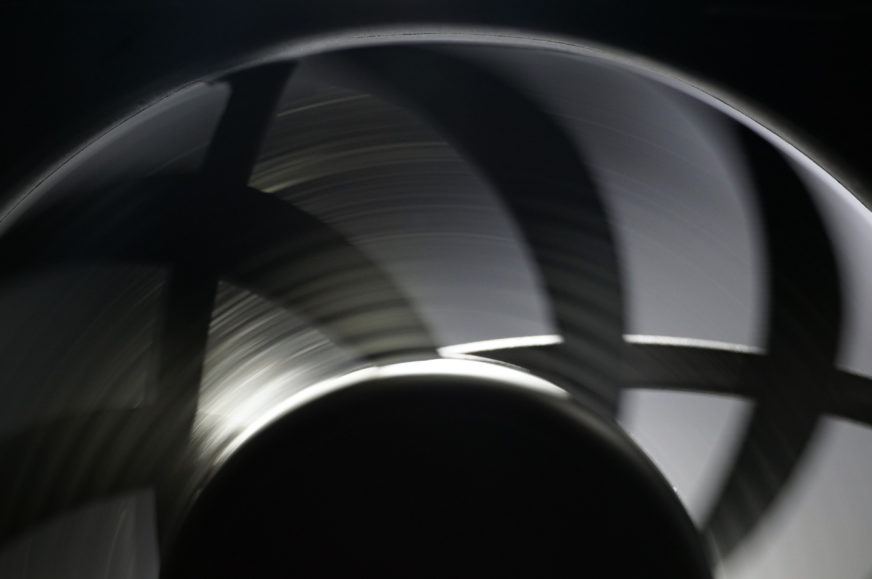
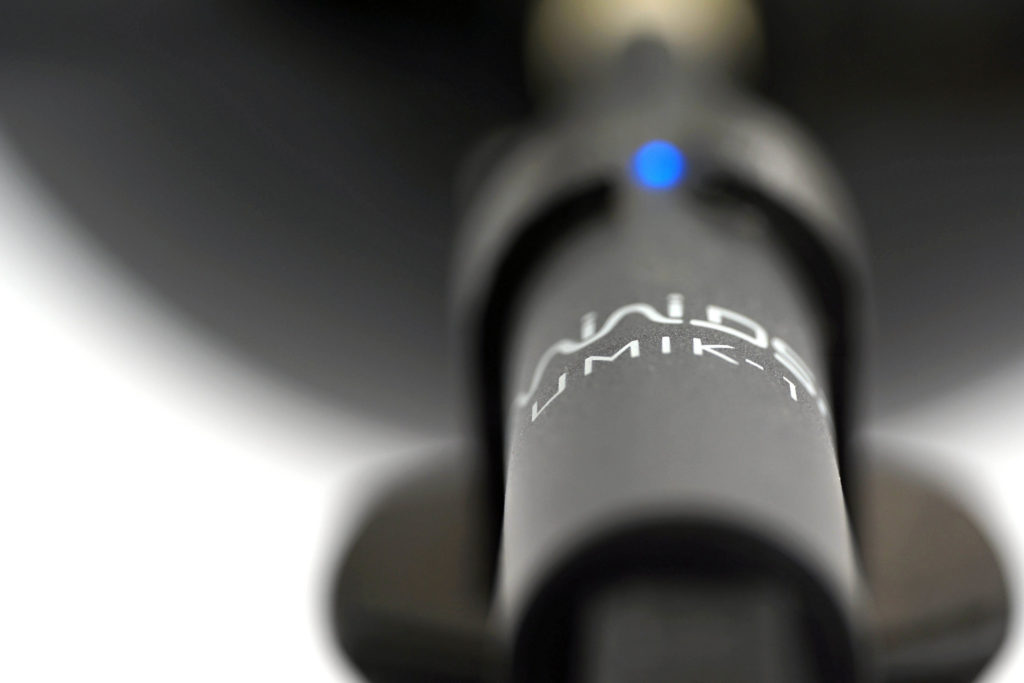
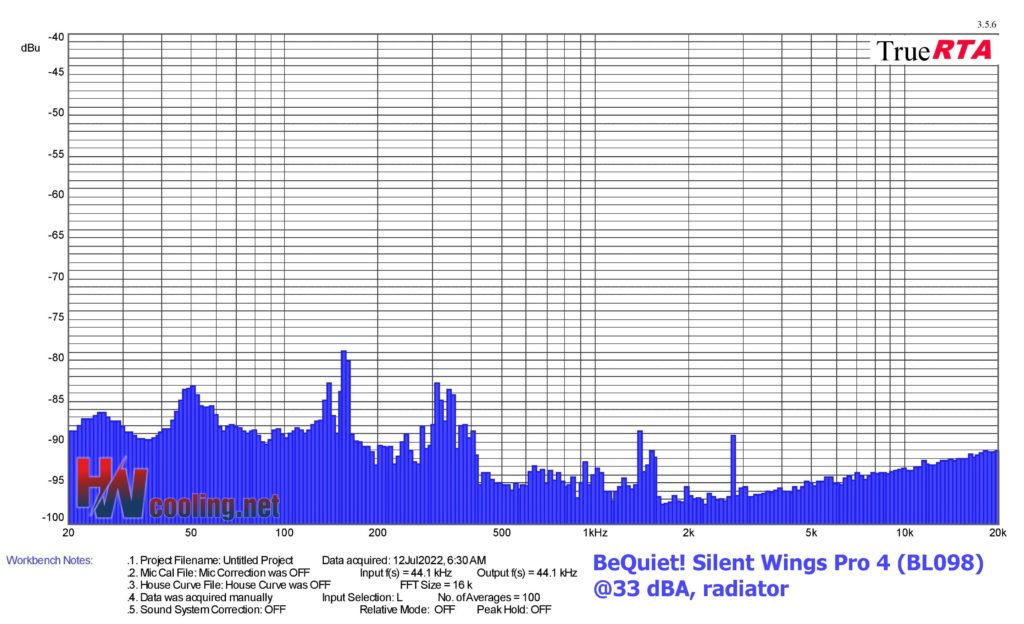
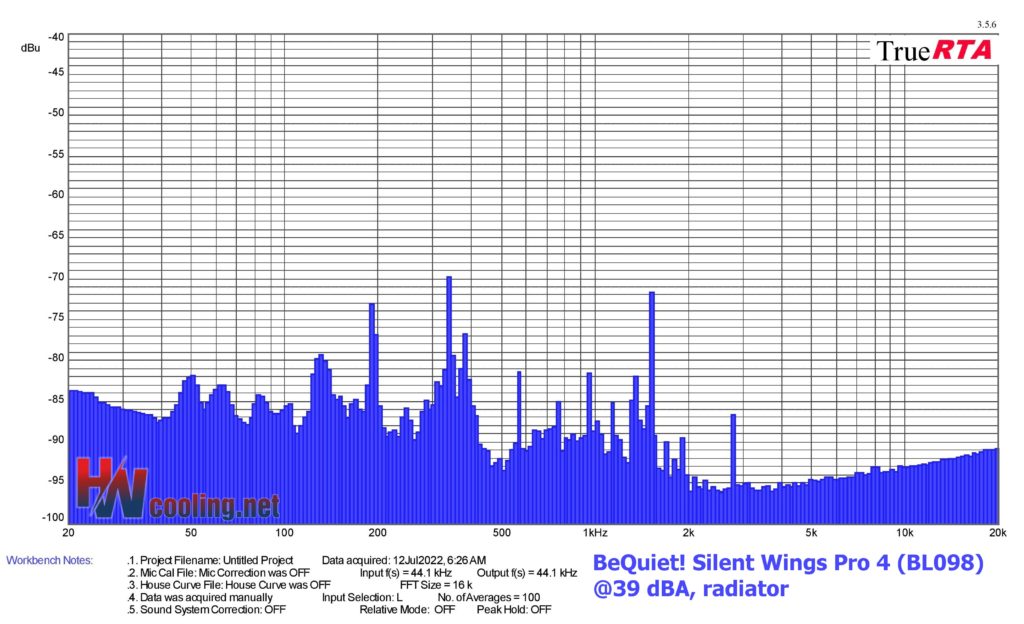
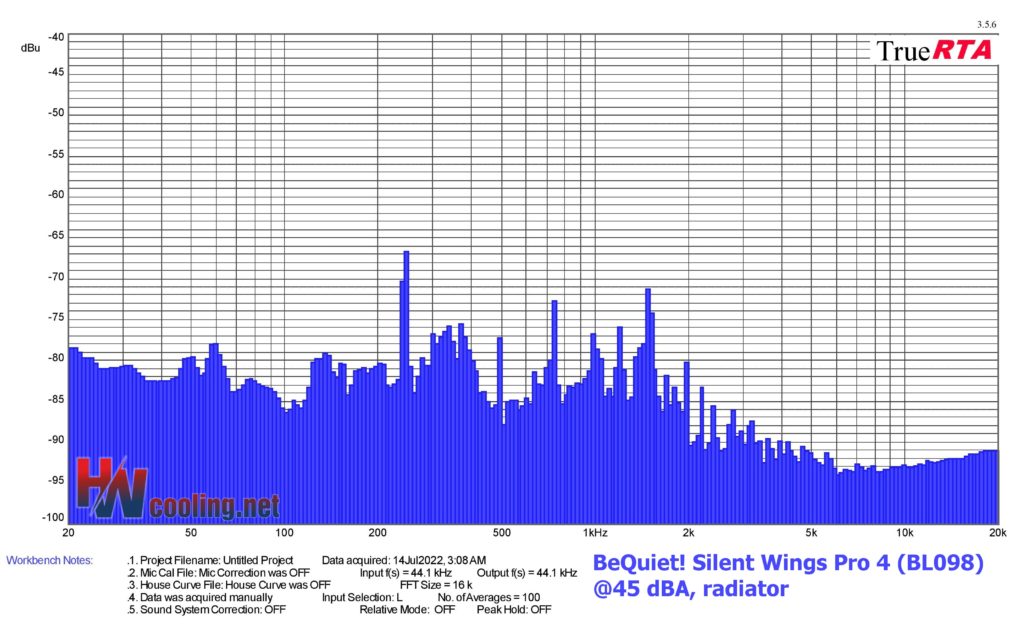


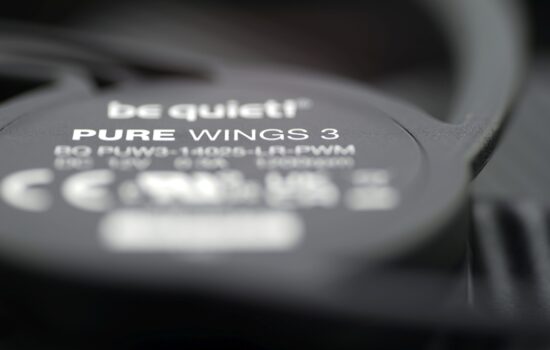


Hi. Do you have any idea of why this fan is capped at 2800rpm at 100%PWM speed? I can see in the test results that you are getting 2800rpm max as I do, but do you know why? All three of my fans are capped at 2800rpm.
Obviously this is caused by the limitations of the fan electronics. At 12,00 V (DC/PWM) the approx. 2800 rpm is simply a ceiling. Most of the BeQuiet! fans we have tested do not reach the max. specified speed. They always just fit within the +/- 10 % tolerance. Anyway, we will address your question to BeQuiet! and if we get an answer, we will write it here in the discussion, but the fact is that most fans are a bit faster compared to the parameters and BeQuiet! has it the other way around.